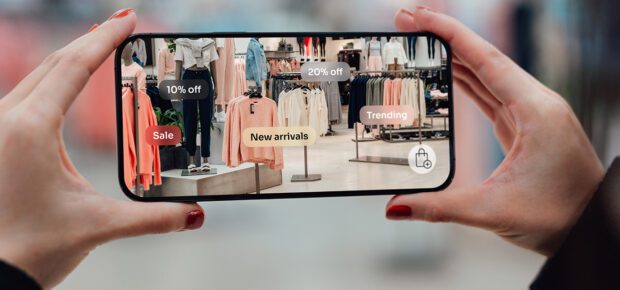November 22, 2022
When you think of popular applications of augmented and virtual reality, retail shopping may not be the first thing that comes to mind. But interest in using AR and VR for shopping and ecommerce is growing. In a 2021 survey, about 20 percent of adults aged 18-34 reported using these technologies for shopping. And a 2022 consumer survey from PwC reported that shopping is the third-most reported use of AR and VR (collectively referred to as extended reality or XR) technology among consumers.
Augmented reality, which imposes a digital image on the real world through a device is used by retailers to help consumers imagine what a purchase would look like outside of the ecommerce store. AR systems can, for example, show you what you would look like with new clothes, or new cosmetics. Virtual reality is often used to create in-store experiences, and to create more immersive versions of e-commerce sites.
These capabilities are available through a number of major retailers. So, what’s behind the added interest now?
For one thing, retailers are capitalizing on research making XR technology easier to use by reducing the mental demands of experiencing a virtual world while inhabiting a physical one.
The long-term rollout of these technologies will be enabled by new technological advances.
“There are two upcoming technologies that will boost AR/VR in the coming decade,” said IEEE Senior Member Sambit Bakshi. “The first is 6G internet that can enable a giga-wide data transfer – one that is essential for the real-time effect. The second are advancements in tiny sensors that can detect even the slightest hand or head movement.”
But technology is advancing today. Here’s the latest:
- More degrees of freedom. Imagine you are wearing a virtual reality headset. You can look up or down. And you can tilt your head to the left or right. And, finally, you can swivel to your left or right. Each of these (up and down, tilted, or left and right) is what’s known as a degree of freedom. As this article from IEEE Digital Reality explains, inexpensive virtual reality systems tend to limit the user to these three degrees of freedom. More expensive units, however, can simulate travel forward and backward, or moving left and right, or going up and down. Devices that could simulate all six degrees of freedom have tended to be hard wired, and more expensive. But costs are coming down, and going mobile.
- Better video capture experiences. Having more degrees of freedom necessarily requires complex camera systems to capture the full environment. But researchers are working out new methods and algorithms that allow easier three-dimensional content capture, sometimes with a single camera, which could lower the cost of production.
- Resolutions and displays are getting better. One factor holding back XR adoption has been the form factor of devices. Bulky, head-mounted units often require users to be tethered to a machine to provide processing power capable of delivering high resolution images. And XR experiences through smartphones have often resulted in grainy images. or low frame rates. As IEEE Digital Reality’s Megatrends for 2021-2030 report notes, smartphone makers are already making devices capable of delivering resolutions above 400 pixels per inch, through better chips and better displays. This may make it easier and more realistic, when people shopping for furniture want to render an image of a new couch into their living room through their smartphone’s AR app.
- Shopping with a friend. Ecommerce has one big drawback when it comes to shopping. It’s not something you can do with your besties. Some brands, however, are experimenting with virtual shopping experiences that allow friends to get together in virtual spaces to try on new, virtual clothes.
- Modeling new store experiences. Retailers are also using extended reality to put themselves in the shoes of the shopper when working out new concepts. Virtual reality allows designers to build virtual store experiences that users can walk through, and to test whether their ideas work. That allows them to experiment with new store concepts and designs without the expense of building out a real one.
“The most significant aspect that will encourage wider adoption is device cost,” Bakshi said. “However, with the commercialization of many vendors and the rise in market demand, reduced device costs will soon be achievable.”
Learn more: If you want to learn more about the latest developments in XR, check out the hours of discussion from the world’s leading experts from IEEE 2022 Conference on Virtual Reality and 3D User Interfaces.






 Why AI Can't Live Without Us
Why AI Can't Live Without Us Bits, Bytes, Buildings and Bridges: Digital-Driven Infrastructure
Bits, Bytes, Buildings and Bridges: Digital-Driven Infrastructure Impact of Technology in 2024
Impact of Technology in 2024 Emerging AI Cybersecurity Challenges and Solutions
Emerging AI Cybersecurity Challenges and Solutions The Skies are Unlimited
The Skies are Unlimited Smart Cities 2030: How Tech is Reshaping Urbanscapes
Smart Cities 2030: How Tech is Reshaping Urbanscapes Impact of Technology 2023
Impact of Technology 2023 Cybersecurity for Life-Changing Innovations
Cybersecurity for Life-Changing Innovations Smarter Wearables Healthier Life
Smarter Wearables Healthier Life Infrastructure In Motion
Infrastructure In Motion The Impact of Tech in 2022 and Beyond
The Impact of Tech in 2022 and Beyond Cybersecurity, Technology and Protecting Our World
Cybersecurity, Technology and Protecting Our World How Technology Helps us Understand Our Health and Wellness
How Technology Helps us Understand Our Health and Wellness The Resilience of Humanity
The Resilience of Humanity Harnessing and Sustaining our Natural Resources
Harnessing and Sustaining our Natural Resources Creating Healthy Spaces Through Technology
Creating Healthy Spaces Through Technology Exceptional Infrastructure Challenges, Technology and Humanity
Exceptional Infrastructure Challenges, Technology and Humanity The Global Impact of IEEE's 802 Standards
The Global Impact of IEEE's 802 Standards Scenes of our Cyber Lives: The Security Threats and Technology Solutions Protecting Us
Scenes of our Cyber Lives: The Security Threats and Technology Solutions Protecting Us How Millennial Parents are Embracing Health and Wellness Technologies for Their Generation Alpha Kids
How Millennial Parents are Embracing Health and Wellness Technologies for Their Generation Alpha Kids Space Exploration, Technology and Our Lives
Space Exploration, Technology and Our Lives Global Innovation and the Environment
Global Innovation and the Environment How Technology, Privacy and Security are Changing Each Other (And Us)
How Technology, Privacy and Security are Changing Each Other (And Us) Find us in booth 31506, LVCC South Hall 3 and experience the Technology Moon Walk
Find us in booth 31506, LVCC South Hall 3 and experience the Technology Moon Walk Virtual and Mixed Reality
Virtual and Mixed Reality How Robots are Improving our Health
How Robots are Improving our Health IEEE Experts and the Robots They are Teaching
IEEE Experts and the Robots They are Teaching See how millennial parents around the world see AI impacting the lives of their tech-infused offspring
See how millennial parents around the world see AI impacting the lives of their tech-infused offspring Take the journey from farm to table and learn how IoT will help us reach the rising demand for food production
Take the journey from farm to table and learn how IoT will help us reach the rising demand for food production Watch technical experts discuss the latest cyber threats
Watch technical experts discuss the latest cyber threats Explore how researchers, teachers, explorers, healthcare and medical professionals use immersive technologies
Explore how researchers, teachers, explorers, healthcare and medical professionals use immersive technologies Follow the timeline to see how Generation AI will be impacted by technology
Follow the timeline to see how Generation AI will be impacted by technology Learn how your IoT data can be used by experiencing a day in a connected life
Learn how your IoT data can be used by experiencing a day in a connected life Listen to technical experts discuss the biggest security threats today
Listen to technical experts discuss the biggest security threats today See how tech has influenced and evolved with the Games
See how tech has influenced and evolved with the Games Enter our virtual home to explore the IoT (Internet of Things) technologies
Enter our virtual home to explore the IoT (Internet of Things) technologies Explore an interactive map showcasing exciting innovations in robotics
Explore an interactive map showcasing exciting innovations in robotics Interactively explore A.I. in recent Hollywood movies
Interactively explore A.I. in recent Hollywood movies Get immersed in technologies that will improve patients' lives
Get immersed in technologies that will improve patients' lives